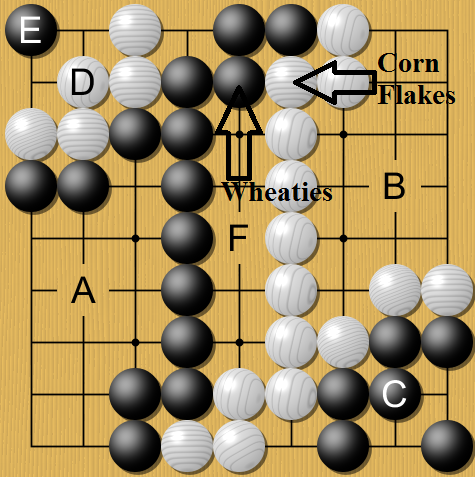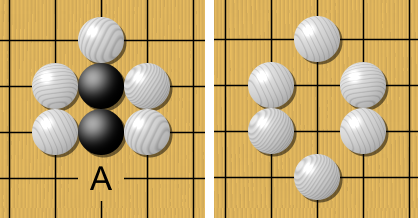
In the ancient game of Go, players compete by placing stones on a grid board with the goal of enclosing the greatest amount of territory with their stones. Think of the board as a two-dimension product space. For breakfast cereals, for example, one axis might be sweetness and the other crunchiness. The goal of a firm is to field a product that has few close substitutes, that faces competition from products that are quite unlike it, and therefore unlikely to lure away consumers of the firm’s product, allowing the firm to raise prices without worrying about triggering a reduction in demand. The goal of a firm, therefore, is to reserve the largest possible extent of product space to itself. But that’s just what a Go player seeks to do: to exclude his opponent from the largest possible expanse of the Go board.
We can think of the stones that a Go player places on the board as differentiated products. A stone’s location on the board corresponds to a particular combination of the two product attributes represented by the Go board as two-dimensional product space. In the cereal example, a stone placed at the center of the board would represent a breakfast cereal that is half sweet and half crunchy. A stone in one corner might represent a cereal that is very sweet and not crunchy at all.
At the start of a game of Go, players place their stones in separate areas, trying to stake out control of whole quadrants of the board, just as firms strive to introduce products that have no close substitutes, ensuring that consumers will be forced to buy the firm’s product at high prices (an animated picture of how a game of Go develops may be found here). We can think of each node in the Go board grid as representing a consumer with a preference for a product with attributes that correspond to that node. If no product has precisely those attributes, the consumer will purchase the product with the closest set of attributes, meaning the product represented by the Go stone on the nearest node to the consumer’s. Placing a stone in an empty quadrant of the board means that the player will get the business of all of the consumers in that quadrant. (Those familiar with the Hotelling location model of differentiated product competition will recognize that this account of Go is just the Hotelling model expanded from one dimension to two. We’re not talking about pizza places along the line that is the Coney Island boardwalk, but pizza places on the grid that is midtown Manhattan.)
Now, firms pioneering a new technology may decide to stop innovating, stop introducing new product flavors, and just coexist in oligopolistic harmony. One of the extraordinary things about Go is that, like firms, the players can stop the game at any time. Whenever both players agree to stop, they count up the territory enclosed by each and the player with the largest territory wins. Just so, when firms collude, the firm with the most desirable product–the product that controls the greatest share of consumer demand–will profit most from the oligopoly.
When to keep fighting and contesting competitors’ markets, and when instead to try to respect competitors’ markets and seek accommodation, is an important question in business strategy. Just as it is in Go. At the start of the game, both players usually believe they can achieve advantage through continued play, and so the game goes on. Competition at the inception of an innovative technology, when a new product space opens up, is often fierce. Think of the competition in streaming video today.
Firms take the battle to each other by striving to make very close substitutes of their competitors’ offerings, cutting into demand for competitors’ products and increasing demand for their own. So it is in Go, too. The players invade each others’ quadrants by placing stones right next to their opponents’, just like firms trying to siphon off rivals’ demand. At the extreme, a firm may create a set of products that so well captures all of the attributes that consumers value in a competitor’s product that demand for the competitor’s product eventually withers and the product is driven from the market. In Go, that happens when one player has placed stones that fully encircle a stone belonging to his opponent. When that happens, the opponent’s stone is removed from the board and the player gains a point. We can think of that point as representing profits enjoyed from having permanently locked up the demand of the consumer represented by the strangled node.
Firms sometimes succeed by driving competing products from the market. But they also often succeed by building up a wall of differentiated products that competitors cannot penetrate. Indeed, the FTC famously alleged in the 1970s that Kellogg did precisely that with breakfast cereals by proliferating the number of cereal flavors that the firm offered. In Go, this is reflected in prolonged struggles between the players to wall off territory (text in Wikipedia accompanying the featured image of this post provides a nice overview of how players control space through these struggles).
Differentiated product competition is the only kind of competition that we have in the real world. If Go is a game of differentiated product competition, does it tell us anything about how to regulate real world competition through antitrust?
Play it and find out.

One reply on “Is Go the Ultimate Antitrust Boardgame?”
[…] concerned with joint bidding in procurement procedures…Heidi Sander Løjmand (How to Crack a Nut)Is Go the Ultimate Antitrust Boardgame?In the ancient game of Go, players compete by placing stones on a grid board with the goal of […]